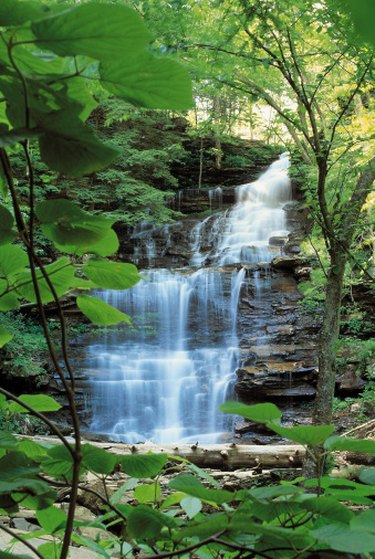
Cooperative extension and state environmental conservation agencies consider tent caterpillars and gypsy moths pests worthy of control programs. This holds true more for gypsy moths than for tent caterpillars. In some cases, gypsy moths can defoliate an entire forest. Tent caterpillars cause problems on a local level, especially with ornamental or fruit trees. Recognizing the difference between them will help you determine when and how to best control an infestation.
Gypsy Moth History
Video of the Day
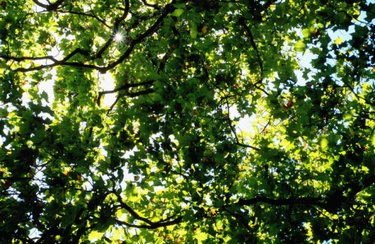
For over 100 years, the federal government has attempted to control the spread of gypsy moths after an experiment went awry. Entrepreneur, artist, astronomer and amateur entomologist Etienne Leopold Trouvelot brought gypsy moths to Medford, Massachusetts from Europe in 1869 in hopes of improving the domestic silkworm industry. The caterpillars have been a bane to Northeastern forests ever since. Gypsy moths are gradually expanding their territory to the south and west. They now reach as far west as Wisconsin and south to North Carolina. They are currently found in 19 states.
Video of the Day
Gypsy Moth

The gypsy moth (Lymantria dispar) has five pairs of blue spots followed by six pairs of red spots in the oldest larvae stage. It prefers dining on oak, but in a full-blown infestation it will eat just about any kind of leaf. Federal government agencies are trying to keep gypsy moths from expanding into new areas rather than trying to eradicate them from existing areas.
Tent Caterpillars

Tent caterpillars are a native species in the United States. The name "tent caterpillar" refers to several species of moth larvae that build silk tents or mats in trees. Tent caterpillars tend to aggregate with each other, especially when their larvae are young, and use the tents for protection. Forest and eastern tent caterpillars are the two species that occur most commonly in the ranges inhabited by gypsy moths.
Forest Tent Caterpillars
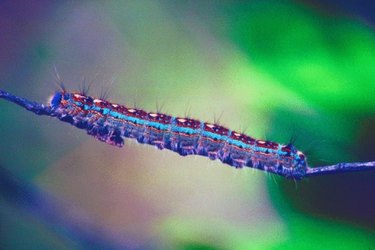
Forest tent caterpillars (Malacosoma disstria) have blue heads and light blue lines down the sides of their bodies. They have white dots on their backs. They feed on broad leaf trees and can cause large areas of defoliation, especially on sugar maples and aspen trees. An infestation can last about three years and may occur every six to 16 years.
Eastern Tent Caterpillars
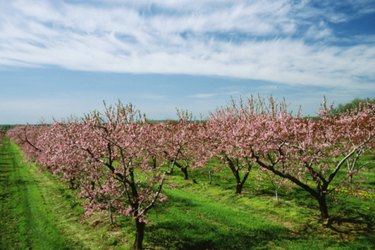
Eastern tent caterpillars (Malacosoma americanum) have white lines down their backs. They have blue and black spots along their sides and black heads. They prefer to feed on cherry, apple and crabapple trees. In large numbers, they can defoliate a tree but they don't generally defoliate an entire area like gypsy moths and forest tent caterpillars.
Control
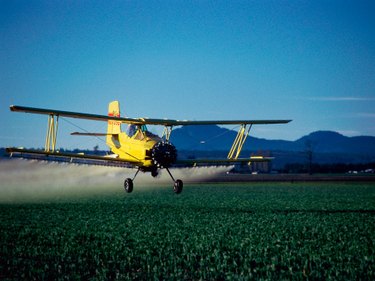
Control needs vary depending on the type of caterpillar and land use. Tent caterpillars are natural to the area and do little lasting damage. Unless a tree is being used for a commercial purpose, allow nature to run its course. Trees will recover from defoliation. Leaves will re-grow by mid-summer. However, work with local state agencies for control of gypsy moths. Mechanical, biological and chemical controls exist for the three types of caterpillars. Biological controls are most affective on young larvae.
- New York State Department of Environmental Conservation: Tent Caterpillars and Gypsy Moths
- New York State Department of Environmental Conservation: Caterpillar Comparison Chart
- University of Wisconsin Cooperative Extension: Gypsy Moth in Wisconsin
- Pennsylvania State Department of Conservation and Natural Resources: Gypsy Moth
- University of Kentucky; College of Agriculture; Eastern Tent Caterpillar
- The University of Maine Cooperative Extension: Gypsy Moth
- U.S. Forest Service: Gypsy Moth in North America
- USDA Forest Service; Forest Tent Caterpillar; Harold O. Batzer and Robert C. Morris